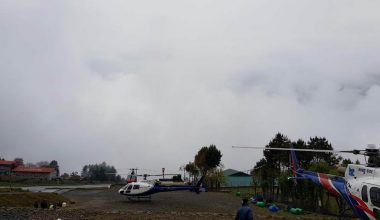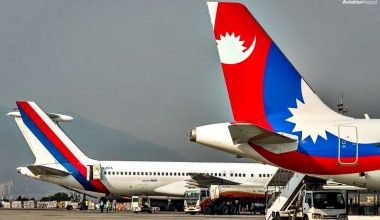
Prospects and importance of Aviation Growth in Nepal
May 7, 2017
Aviation, the art of aeronautics, is a vital tool for economic growth and investments of a country. Transportation and connectivity are the two major aspects highly influenced by aviation. Air connectivity to the remote regions of a country is essential for many reasons including economic transformation, uplifting of living standard and much more. If we suppose or realize aviation as a country then it will be the source of huge economy in the world with the fact that it enhances numerous jobs, boosts up economic standards and supports sustainable economic growth. In addition, aviation enables a country’s integration into the global economy creating a huge and an effective platform for international business. Nepal, being the developing country requires aviation as the most important and powerful tool for the economic progress. So, the aviation growth in Nepal is a matter of huge concern to the government, respective aviation authorities and aviation enthusiasts too.
The present situation of aviation in Nepal is quiet appreciable due to the fact that the aviation industry is growing in a steady manner and we have also seen some effective investments in aviation. Moreover, the amount of aviation accidents are minimal as compared to the past. Currently, Nepal has only one international airport however, a couple of other international airports are in the verge of development. Likewise, the airline companies are also expanding their amount of fleet and destinations. International companies have also been depicting keen interest to invest for the aviation industry in Nepal. These statistics have been proving that the aviation growth is taking place in Nepal with some pace. But this pace cannot be rampant unless the positive and negative aspects and challenges of aviation in Nepal can be faced with optimum dedication and passion.
Aviation is always a challenge for Nepal because it is a geographically complex country. If we replay the aviation history, we can explore lots of fatal air crashes in the past that has destructed huge amount of property and human life. The majority of the incidents were recorded due to the adverse geographical and climatic conditions of Nepal. There are lots of remote regions not accessible by air till now and those remote regions which are accessible have challenging airstrips, vibrant terrains and difficult approach and landing procedures making it vulnerable for air transport. Furthermore, the aviation industry here in Nepal lacks skilled manpower and modern technologies which are the factors highly responsible for aviation safety. The one and only international airport of Nepal is using the technologies that have already faded out. This information shows the poor aviation management in Nepal which could be the obstruction for aviation growth if not taken into consideration.
By providing the world’s only rapid worldwide transportation network, aviation enhances tourism and international business. Nepal, being a tourism and a developing country has lots of positive aspects of aviation. The aviation growth deepens the relation between connectivity and productivity so, the investment in air transport capacity in developing countries like Nepal, where connectivity is currently relatively low, will have a huge impact on their economic success than a developed country with a similar level of investment. Nepal welcomes a considerable number of tourists yearly and tourism has been the greater source of national income so far. Aviation is the tool that has made this possible, therefore, if Nepal invests and grows aviation then it is pretty sure that not only economic standard will be accelerated, many new employment opportunities will arise.
But poor standard and management from government and aviation authorities have produced some negative impacts in the aviation industry in Nepal. Airport security and management is really vulnerable here. Passengers have to spend hefty time and counteract difficult situations to access the facilities of airports. Also, the increasing air traffic has been obstructing the smooth flow of flight operation. Smuggling and theft cases from the airport come into the news frequently which has been degrading the reputation of the aviation industry. The airport environment is polluted, runway site is unsafe and there is no any sign of concern towards it. In addition, the aviation regulatory body is unable to implement strict rules to maintain aviation safety and standards. The country’s sole international airport, TIA, is facing the problem of huge air traffic and insufficient parking space after the airline operators have been adding fleets in a relentless manner. These all aspects are the obstacles for aviation growth in Nepal.
For the proper aviation growth in Nepal, government and aviation authority must act strictly and effectively in every aspect of the aviation industry. Civil Aviation Authority of Nepal must implant strict rules to improvise aviation safety and meet European Aviation safety standards. Airport security and management must be enhanced by the government. If these things happen then investors, aviation enthusiasts and airline operators are encouraged to expand the aviation industry. Investors and new airline operators must be appreciated and the facilities and permissions they require must be granted. The construction of new international airports and renovation of existing airports must be carried with pace. In order to expand aviation industry, the amount of aircraft with latest technologies and safety standards must be increased but the other factors such as runway standards and safety, ATC with modern equipment and technologies must be taken into considerations. The airline companies like Buddha Air, Himalaya Airlines are relentless for the aviation industry in Nepal. Buddha Air owns a hanger and is also certified for Maintenance, Repair and Overhaul of certain aircraft. Recently, Shree Airlines added two Bombardier CRJ-200 aircraft for continuing jet operation in Nepal after Saurya Airlines who owns two CRJ-200. Besides, helicopter companies are also elevating with addition of modern aircraft. In near future, other aspiring companies are expected to step into Nepali aviation. So, respective authorities must create a platform for such companies to expand further. Besides this, the national flag carrier ‘Nepal Airlines’ is highly responsible for aviation transformation because it is the pride and reputation of the country and it has the power to expose Nepal’s aviation capability to the international platform.
Currently, the aviation industry of Nepal has been receiving lots of aircraft, however; it has not proved the industry strong enough to enlighten further. Along with the addition of aircraft, the infrastructures must be taken into account. The airports will shortly encounter lack of parking spaces and also face the hefty air traffic. The construction of new international airports is not getting enough pace and the concern from the authorities has been lacking. Proper aviation safety is not exercised here which may result worse scenario in future.
The probability of aviation growth in Nepal is in strong hands if above-mentioned challenges, positive and negative aspects, requirements are taken into keen consideration by the government and the aviation authorities. Aviation is a huge platform for Nepal’s economic growth as it enhances tourism industry, provides greater access to resources and to international capital markets. Hence, increasing airports, implementing strong safety standards in ground, sky and aircraft, encouraging airline companies and investors, deploying skilled manpower are the major factors for aviation growth in Nepal.






